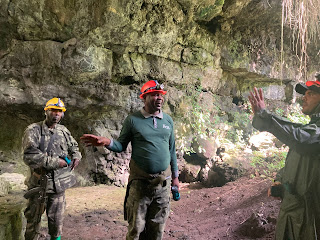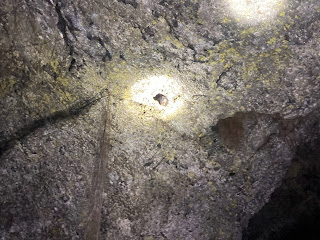December 5th, 2023
One of the big attractions in this area of northern Rwanda is
to see the mountain gorillas. American Dian Fossey, who studied
the gorillas for 19 years here. She wrote
the famous book “Gorillas in the Mist” which I have just finished reading. Since I already saw the gorillas in Uganda,
at a cheaper rate than in Rwanda ($700 USD vs $1300 USD), I wasn’t going to do it
again, but I contemplated the 4-5 hour hike to the Karisoke Research
Center, which Dian established in 1967.
However, after a late night last night, plus a lot of rain overnight, I opted
to check out Musanze Cave. I had read
about them online and you can explore 2 kilometers of the cave. I mentioned the plan to my new South African
friends, and they were interested in joining.
Peace, a lady who works at Red Rocks Rwanda, called a taxi
for us. Right from the get go, our driver
had a bad vibe about him, which all of us picked up. We drove the 7 km north to Musanze and then
went another 10-12 kilometers towards the base of one of the volcanos in the
area. Just before arriving at the Volcano
National Park Headquarters, there was a lodge with some huge wooden statues of animals. The biggest was a mountain gorilla and her
baby but there was also an elephant, giraffe and some other ones. We asked our taxi driver if we could stop to
take pictures. His English wasn’t very
good but it was obvious that he understood the request. He conveyed that we would pass by this on the
way back from the headquarters and we could stop then. There were some big dark storm clouds over
the volcano and I wondered if it wouldn’t be raining soon.
We entered the headquarters and were the only tourists
there. In the main office, a ranger
named Isaiah helped us to get our permits for caving. He took our passports and then we had to pay
the $50 park entrance fee by credit card.
This proved to be a problem with the South Africans due to the type of
credit card that they have. While we
were in the building, the heavens opened up and it poured the hardest I’ve seen
in my month in Africa…it was torrential.
Eventually Beyers’ card worked but we must have been there for an
hour. After paying, we still had to wait
for a guide to show up along with equipment for spelunking: a helmet and a flashlight.
The view of a nearby volcano from the headquarters:
I had to take a pic of this: individual electrical sockets above each urinal...just in case you need to charge your phone. Huh, how long of a pee do you have to take?
A pickup truck finally showed with 4-5 guys and after we
were able to corral Koster and Beyers from some extracurricular activities, we
were off. We had to follow the truck in
our taxi, so of course we were unable to stop to take photos of the amazing
wooden statues…thanks Mr. Taxi Driver.
I stole these from online...what we had hoped to stop and photograph.
Our guide, Kovit, was the complete opposite to the taxi
driver, smiling, jovial and just exuding positive energy. Along with Kovit, we were joined by a man
carrying an AK-47 named Neto. We had to
ask why a machine gun was required in a cave.
Well, I guess occasionally there can be a jackal or feral dogs underground…seemed
unlikely to us, but hey, why not go spelunking with a gun?!?
During a pre-cave briefing, Kovit told us that there were
three sections that we would walk through.
The cave system was actually a big lava tube and extended about 17-18
kilometers but only the first 2 have been made suitable for tourists.
It was time to enter the first section of the cave. There
was a nice 10-15 foot wide stone footpath throughout the cave. A few of us remarked about how much work it
must have been to make it. The roof of
the cave ranged from 15-40 feet above us.
It was a pretty impressive cave.
I mentioned to Stefan that at some point we should all turn off our
lights to see how dark it really was in this cave…and about ten minutes later, without
any prompting from me, Kovit suggested that we extinguish our flashlights. Wow, it was super dark.
Kovit mentioned that during the genocide in 1994, some
Tutsis were hiding in the cave. What a
crazy thought. It would have been cold,
damp and complete darkness…but I guess that’s still a lot better than getting
hacked up by a machete.
As we exited the first, and longest section of our tour, it
was raining but thankfully we only had to walk about 100 meters to descend back
into the cave. This section was not as
cavernous as the first. We were hoping
to see bats but didn’t find any.
At the start of the third and final part of the cave, there was
a side entrance that was about 5 feet high into a room about 40 feet in
diameter. As we looked at it, Kovit
explained that in the past, up until the 1950s-1960s, people sick with contagious
diseases were brought here to isolate them from the general population. Imagine that, you’re sick and feel terrible,
and you’re made to stay in a dank cave?!?
Nasty. Although it wasn’t the
normal way that tours were taken, Koster asked if we could go inside, and Kovit
said yes as it actually met back up with the main section of the cave. What I thought was astounding in this part of
the cave were the roots that hung down about 6-8 feet from the ceiling. Incredible that the vegetation in the forest
above could find its way through the rock…only to be disappointed and not
finding any nutritious soil!
Luckily our little deviation sent us into a part of the cave
where we did find two bats sleeping.
They were tiny little guys.
We ended up spending about an hour in the cave and although
it was pricy, everyone one was glad that we did it. Kovit ordered four motorcycle taxis for us to
head into the town center of Musanze.
The South African boys attempted to get money at ATMs and all of us got a sim card. I picked the wrong person behind the counter as somehow it took an hour for me to get a sim card and a data package. By this time, we were all ready to head back to Red Rocks Rwanda for some beers and dinner…it had been a full, but fun spelunking of an afternoon!










.jpeg)

.jpeg)




No comments:
Post a Comment